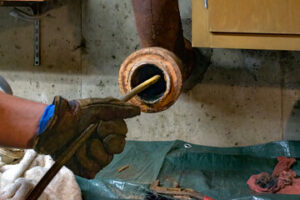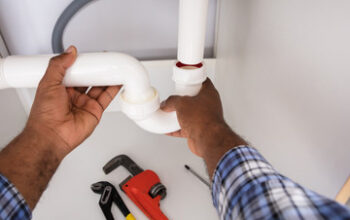Drain cleaning is essential for a healthy and smooth-running residential plumbing system. Clogged drains can lead to costly damage that may require expensive repairs and replacements.

You can avoid these problems by regularly using DIY methods for drain cleaning. These natural, safe products are much cheaper than commercial drain cleaners and don’t leave dangerous chemicals behind in your pipes or home. Visit https://www.proplumbersauroraco.com/ for more details.
Many people think that boiling water is the ideal solution for clogged drains, but it isn’t always as effective as you may expect. Pouring boiling water down a drain pushes the blockage deeper into the pipes, and while this method can work for hair or soap scum in bathroom sinks, it won’t break up oil, grease or solid fats that are a common cause of kitchen drain clogs.
Instead, try using a combination of baking soda and vinegar to naturally clean your drain. Baking soda (sodium bicarbonate) is safe to use in your plumbing and helps to dissolve mineral deposits that can build up inside the drain pipes. Vinegar, on the other hand, is a natural deodorizer and contains mild disinfectant properties that can help to eliminate odors and reduce bacteria. When combined, these two natural cleaners can dislodge most drain clogs and help to prevent them from returning in the future.
To begin, remove the drain stopper and then carefully pour one cup of baking soda down the drain followed by a half cup of distilled white vinegar. Be careful not to spill, as the mixture will fizz up and can be quite messy. The combination of the acidic vinegar and alkaline baking soda can help to dissolve clogs by breaking them down into smaller particles that can be washed away by the hot water.
Once the bubbling has stopped, slowly pour the rest of the pot of boiling water down the drain. Repeat this process two to three times, waiting a few minutes between each pour to ensure that the hot water has time to work its magic on the clog. If the clog is particularly stubborn, try adding a few tablespoons of grease-fighting dish soap to the mixture to help break down greasy oils and grease that can accumulate in your drain pipes.
This home remedy is safe to use in most homes, but be cautious if your plumbing features plastic pipes or other materials that could be damaged by the heat of the boiling water. If the clog doesn’t dislodge after several attempts, it is probably best to call in a professional for more advanced drain cleaning techniques.
Baking Soda & Vinegar
While baking soda and vinegar may be well known for their volcanic reaction that produces foamy fizzing in science class, this combination can also be a powerful drain cleaning tool. This DIY solution is inexpensive, easy to find and does not contain the potentially harmful chemical sodium hydroxide (or lye) found in most store-bought drain cleaners.
Baking soda and vinegar work by way of a simple chemical reaction to produce carbonic acid, which dissolves and breaks up clog materials. This reaction is effective at dissolving light grease buildups and loosening soap scum. However, this is not a good solution for major clogs and should only be used as a preventative measure.
To use baking soda and vinegar, remove any excess water that may have backed up over the drain and then pour one cup of baking soda directly down the drain. Follow this with one cup of vinegar, poured down the drain at the same time as the baking soda. This should cause a rapid, vigorous chemical reaction that will lift and break up most soap scum and greasy hair buildup.
After the bubbling and fizzing has stopped, flush the drain with hot water. Repeat as needed to keep the drain clean.
Another option is to combine a small amount of lemon juice with the baking soda and vinegar. Lemon’s natural acid content can be helpful in breaking down a variety of organic substances, such as hair and grease.
When using this mixture, it’s important to note that it is only as effective as the length of time it takes for the reaction to occur. If the clog is still not dissolving after an hour, consider trying a different method of unclogging, such as using a plunger or removing the trap to manually push down the clog.
If neither of these methods opens a clogged drain, it’s probably necessary to call a professional plumber. While vinegar and baking soda can get rid of some stubborn food residues, a severe clog requires professional tools to be fully removed. Likewise, using these homemade solutions on a regular basis can lead to damage or cracks in the pipes over time.
Enzymatic Cleaners
Unlike chemical cleaners, enzyme drain cleaners do not contain any dangerous chemicals. Instead, they contain bacteria and enzymes that can digest organic materials like hair, food waste, mildew and mold. This type of drain cleaner may not be as strong as chemical cleaners, but it is still capable of removing some stubborn clogs.
These types of drain cleaners are non-toxic and safer to use around family and pets. Additionally, they do not require the same level of heat or pressure to break down the clog and are safe for septic tanks. However, they also do not work as quickly or as effectively as some other types of drain cleaners.
Bacterial drain cleaners are a popular choice for those who want to avoid harsh chemicals but are also looking for a reliable way to clear a stubborn clog. These drain cleaners are formulated with a combination of bacteria cultures and concentrated enzymes. Once mixed with water, the bacteria and enzymes start feeding on the organic material that is causing the blockage. Over time, the bacteria will digest the material and break it down into smaller molecules that can be easily dissolved by water.
The only drawbacks of bacterial cleaners are that they are not as effective at clearing larger, more stubborn clogs and that they work much slower than chemical cleaners. This can be frustrating for homeowners who are trying to get rid of a particularly stubborn clog.
Additionally, bacterial cleaners may not be as effective at breaking down mineral deposits or grease clogs. This is because the bacterial process does not penetrate as deeply into these types of materials.
If you are interested in using a bacteriological drain cleaner, be sure to follow the manufacturer’s instructions closely. It is important to mix the cleaner with enough water to create a solution that is viscous. This will help it move through the pipes more easily. It is also recommended to use a drain cover or screen over the drain to prevent debris from getting into the pipe. Finally, it is essential to rinse the pipes with hot water after each use. This will help flush out the remaining cleaning solution and prevent any buildup of grime or odors.
Chemical Cleaners
Chemical drain cleaners come in liquid, gel and powder form and promise to dissolve hair, grease and food debris that block drains. They are readily available in supermarkets, hardware stores and even big box retailers. They are a quick and easy solution to clogged sinks and work well—at least in the short term. However, if you use chemical drain cleaners too often, you risk damaging your pipes and creating more expensive problems than they solve.
Most chemical drain cleaners are caustic, generating heat to melt and break down organic materials. They also work through chemical reactions, either giving or taking away electrons to clog particles. This process liquefies grease, soap scum and oils that are solid at room temperature, allowing them to flow down the drain.
Caustic chemical drain cleaners are lye-based substances that give off heat and oxidize proteins, fats and other debris that create blockages. They are best suited for kitchen drains where food-based clogs occur. Oxidizing chemical drain cleaners, like household bleaches and nitrates, release gas and heat by releasing sodium hydroxide ions to break down clogs. These are effective for toilets and other types of clogs.
Acidic chemical drain cleaners, like sulfuric and hydrochloric acid, are very strong chemicals that can damage pipes. They work by donating or taking away electrons to clog materials, including metals such as iron and copper. These clog-busting chemicals dissolve congealed grease and other materials by dehydrating them.
When using chemical drain cleaners, it’s important to follow the directions carefully. These products can be dangerous, posing health risks to your family and pets and polluting the environment when they seep into groundwater or rivers. If you’re concerned about damage to your plumbing system, contact a professional plumber for help. A licensed plumber has the knowledge and skills to safely clean your drains without causing additional damage or risking your health. And if the clogged drain returns, they can diagnose any underlying issues and correct them to prevent future blockages. If you’re looking for an alternative to chemical drain cleaners, try baking soda and vinegar or one of the other natural methods described above.

